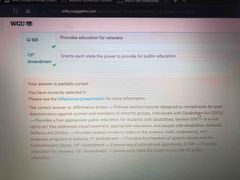![]()
![]()
![]()
Use LEFT and RIGHT arrow keys to navigate between flashcards;
Use UP and DOWN arrow keys to flip the card;
H to show hint;
A reads text to speech;
22 Cards in this Set
- Front
- Back
|
Dame schools |
Education that was delivered in the homes of women, usually consisting of the basics of reading and writing. |
|
|
Latin grammar schools |
Early schools that followed a classical curriculum consisting mainly of Latin and Latin texts, with some Greek. |
|
|
English schools (academies). |
Schools that followed a practical curricular them rather than a classical curriculum focused solely on Latin and Latin readings. |
|
|
Common school movement |
The movement to provide universal education and schools that would serve all children at public expense. |
|
|
Efficiency movement |
Schooling that was designed to prepare students for life in the world of work, with an emphasis on conformity, following directions, rote learning and memorization, and strict rules of comportment. |
|
|
English – only rule |
Rule barring Mexican American children from speaking Spanish in public schools. |
|
|
Eight – year |
A study in the period of the 1930s that compared the progressive approach to education with the traditional approach, and found that the progressive approach produce more intellectual curiosity and drive and higher levels of critical thinking and judgment. |
|
|
Individuals with disabilities education act (IDEA). |
Federal legislation protecting the rights of students with disabilities to receive a free, appropriate education that meets their needs. |
|
|
Americans with disabilities act (ADA) |
Federal legislation protecting the rights of children and adults with disabilities in society at large, rather than only in educational settings |
|
|
Least restrictive environment (LRE) |
Students with disabilities are to be educated in the learning environment that poses the fewest restrictions on their lives as students and that provides the most opportunities for interaction with nondisabled peers |
|
|
Individualized education plan (IEP) |
A legal document defining the educational program and related services for a specific student who has a disability. |
|
|
Early intervention |
Special education services for young children from birth to age 5 |
|
|
Early intervention |
Special education services for young children from birth to age 5 |
|
|
Transition services |
Special education services to help adolescents and young adults with disabilities make the transition from the school setting to the “real world” of work and living away from home, whether in a protected or a completely independent living or work situation. |
|

Milestones |
Milestones |
|
|
Local education agency (A) |
A term used to describe the local school district |
|
|
Per pupil expenditure |
The average total amount of money that is spent per pupil each year, which varies greatly from state to state. |
|
|
Elementary and secondary education act (ESEA |
A major piece of federal legislation that provides federal direction to education and federal funds for schools, first passed in 1965 |
|
|
Categorical aid |
Federal funding to school districts to support a specific category of federal education program. |
|
|
Title I X |
Federal legislation designed to ensure equity between men and women in education. |
|
|
National board for professional teaching standards (NBPTS) |
An organization that reviews representative work of experienced teachers to determine whether their work merits their gaining board certification as accomplished teachers. |
|
|
American with disabilities act (ADA) |
Federal legislation protecting the rights of children and adults with disabilities in society at large rather than only in educational settings. |

